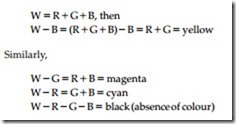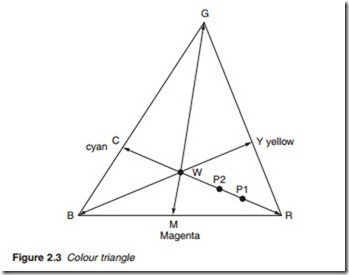Primary colours
Cones themselves are of three different types. One is energised by red, the second by green and the third by blue. These colours are known as primary colours. Colours other than the three primary colours are perceived through energising two or more types of cones simultaneously. For example, the sensation of yellow is produced by energising the red and green cones simultaneously. Other colours may be produced by mixing different pro- portions of primary colours. This is known as additive mixing. For example
Yellow, magenta and cyan are known as complementary colours, comple- mentary to blue, green and red, respectively. A complementary colour produces white when added to the third primary colour. If, for instance, yellow is added to blue, then
The colour triangle
The chrominance content of a colour picture may be represented by the colour triangle shown in Figure 2.3. Pure white is represented by a point W at the centre of the triangle; other colours are represented by phasors (or vectors) extending from the centre W to a point on or within the triangle. Phasors going to the three corners of the triangle WR, WG and WB repre- sent the primary colours, red, green and blue. Other colours such as yel- low are represented by phasor WY with point Y falling between its two primary components, red and green. Phasors for cyan (WC) and magenta (WM) are constructed in a similar way.
Saturation and hue
Phasor WR in Figure 2.3 represents a pure red with no trace of any other colour present. It is said to be fully saturated. Desaturation is obtained when white is added to a pure colour. For instance, if white is added to
red, desaturated red or pink is produced. On the colour triangle, this is represented by moving along phasor WR away from R (pure red) and towards W (pure white). Point PI thus represents desaturated red, or pink, represented by phasor WP1. A greater desaturation produces a shorter phasor; WP2 represents pale pink, and so on. The phasor length represents saturation; the phasor direction or angle represents hue. Hue denotes the principal primary component of a colour. For instance, the primary colour for pink is red; hence its phasor is in phase with the pure red phasor WR. A less saturated red would, say yellowish red; its phasor would be shifted towards WY or towards WM. Yellow itself has two primary colours and hence its phasor falls between red and green. Similarly for magenta. In this case, WM falls between red and blue.


